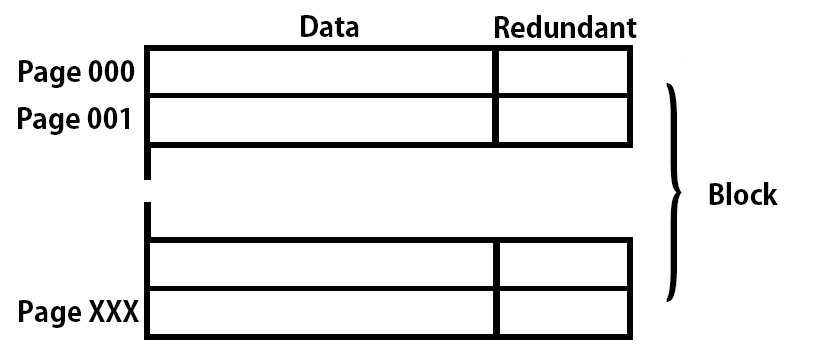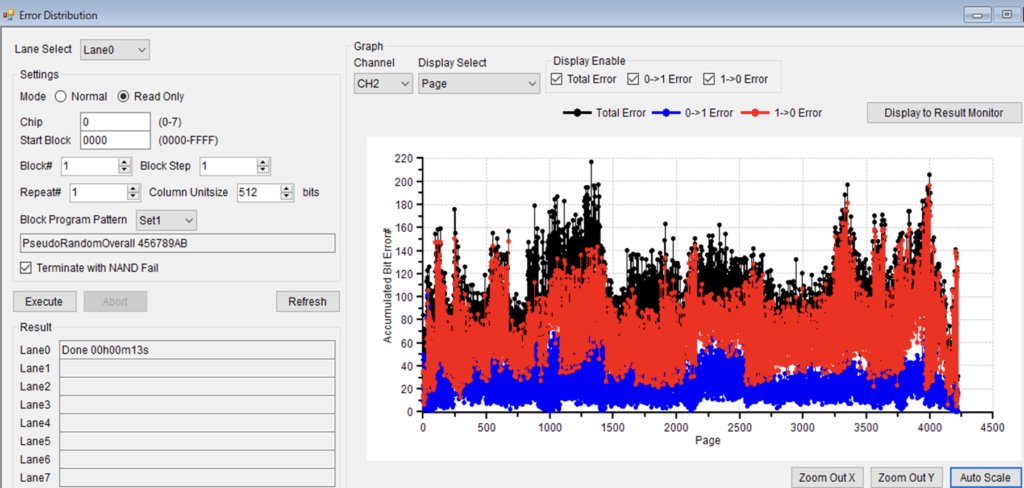Introduction to Script 4
The minimum unit for erasing, writing, and reading NAND Flash Memory (hereinafter referred to as NAND) is as follows due to its structure.
| ERASE | Batch erase in blocks |
| PROGRAM | Page unit (data section + redundant section) |
| READ | Page unit (data section + redundant section) |

The related commands above are introduced below.
Several types of commands are available depending on the application, and it also supports multi-chip and multi-plane.
Please see the SigNAS3 Operational Guide for more information,
ERASE command
BLOCK unit・・・Erases the specified block
| BKERAS | Block Erase |
| BKERMC | Block Erase MultiChip Target chips are specified using bitmap-compatible parameters. |
| BKEMPx | Block Erase MultiPlane It erases a total of x blocks in different planes specified by parameters. |
| BEMCPx | Block Erase MulitiChip MultiPlane |
PROGRAM command
PAGE unit・・・Programs the specified page..
| PGPROG | Page Program |
| PGPGMC | Page Program MultiChip Target chips are specified using bitmap-compatible parameters. |
| PGPMPx | Page Program MultiPlane Programs pages in a total of x blocks in different planes specified by parameters. |
| PPMCPx | Page Program MulitiChip MultiPlane |
The following three types of program patterns can be specified using parameters.
| INCRMT | increment pattern |
| RANDOM | pseudorandom pattern |
| BUFFER | Buffer pattern (pattern file prepared in advance by the user) |
BLOCK unit・・・Programs the specified block.
| BKPROG | Block Program |
| BKPGMC | Block Program MultiChip Target chips are specified using bitmap-compatible parameters. |
| BKPMPx | Block Program MultiPlane Programs all pages in a total of x blocks in different planes specified by parameters. |
| BPMCPx | Block Program MulitiChip MultiPlane |
In addition to the above PageProgram pattern, it is possible to set the following 3 types of program patterns, for a total of 6 types.
| ICROVL | Increment pattern (pattern initialization is performed at the beginning of every page) |
| RDMOVL | Pseudo-random pattern (seed initialization performed at the beginning of every page) |
| BUFATA | Buffer pattern (assign buffer 0000 to Page0, buffer 143F to Page5183) |
READ command
PAGE unit・・・Reads the specified page. No data transfer is performed.
| PGREAD | Page Read |
| PEREAD | Page Read with Extend Address It can be specified an extended address. |
| PGRMPx | Page Read MultiPlane Reads pages in a total of x blocks in different planes specified by parameters. |
| PERMPx | Page Read MultiPlane + Extend Addresss It works similar to PGRMPx, but allows you to specify extended addresses. |
| PGRDDM | Page Read and Dump It reads the specified page and saves the read data to Dump File. |
| PGRDCP | Page Read and Compe It reads the specified page and compares it to the specified pattern. Save the location of the mismatch and the comparison result (XOR value, where the mismatched bit is represented by a 1) in a Compare File. |
The following three types of comparison patterns can be specified using parameters.
| INCRMT | increment pattern |
| RANDOM | pseudorandom pattern |
| BUFFER | Buffer pattern (pattern file prepared in advance by the user) |
| PERDDCP | Page Read and Compare with Extended Address It works similar to PGRDCP, but allows you to specify extended addresses. |
| PGRDEC | Page Read and Error Count It reads the specified page, compares it with the specified pattern, and counts the number of errors. Save error count results to Error Count File. |
In addition to the 3 types of PGRDCP mentioned above, you can specify 5 types of comparison patterns, including the following 2 types, using parameters.
| ICROVL | Compatible with Block Program ICROVL |
| RDMOVL | Compatible with Block Program RDMOVL |
| PERDEC | Page Read and Error Count with Extended Address It works similar to PGRDEC, but you can specify an extended address. |
| PGDUMP | Page Dump It gets the NAND cache data and saves it to Dump File. |
| PGCOMP | Page Compare It gets NAND cache data and compares it with the specified pattern. |
| PGSRDM | Page Softbit Read and Dump It reads the soft bit of the specified page and saves the read data to Dump File. |
| PESRDM | Page Softbit Read and Dump with Extend address |
BLOCK unit・・・Read all pages of the specified block.
| BKREAD | Block Read |
| BEREAD | Block Read with Extend Address It works similar to BKREAD, but allows you to specify an extended address. |
| BKRDDM | Block Read and Dump It reads all pages of the specified block and saves the read data to Dump File. |
| BERDDM | Block Read and Dump with Extend Address It works similar to BKRDDM, but you can specify an extended address. |
| BKRDCP | Block Read and Compare It reads all pages of the specified block and compares them with the specified pattern. Save the location of the mismatch and the comparison result (XOR value, where the mismatched bit is represented by a 1) in a Compare File. |
The following six types of comparison patterns can be specified using parameters.
| INCRMT | Increment pattern (pattern initialization is performed at the beginning of every page) |
| ICROVL | Increment pattern (pattern initialization is performed at the beginning of the first page of the block) |
| RANDOM | Pseudo-random pattern (pattern initialization is performed at the top of every page) |
| RDMOVL | Pseudo-random pattern (pattern initialization is performed at the beginning of the first page of the block) |
| BUFFER | Buffer pattern |
| BUFATA | Buffer pattern (assign buffer 0000 to Page0, buffer 143F to Page5183) |
| BERDCP | Block Read and Compare with Extend Address It works similar to BKRDCP, but allows you to specify extended addresses. |
| BKRDEC | Block Read and Error Count It reads all pages of the specified block, compares with the specified pattern, and counts the number of errors. Save error count results to Error Count File. |
| BERDEC | Block Read and Error Count with Extend Address It works similar to BKRDEC, but you can specify an extended address. |
The GUI is also equipped with NAND read and comparison functions as shown below.


